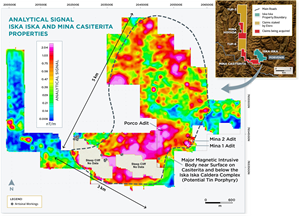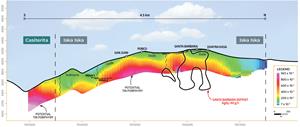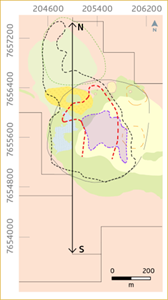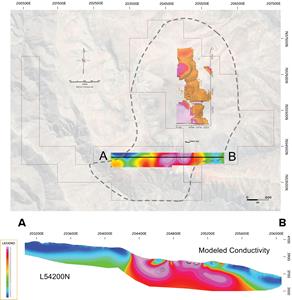- Magnetic data strongly suggest that a large intrusive body lies below the Iska Iska Caldera Complex and that it is nearer to surface on the Casiterita property. This intrusive is approximately 5km long by 3 km wide.
- Diamond drilling and geophysical surveys are in progress to test for a potential major tin porphyry south of Iska Iska and on the adjacent Casiterita property.
TORONTO, Feb. 14, 2023 (GLOBE NEWSWIRE) -- Eloro Resources Ltd. (TSX-V: ELO; OTCQX: ELRRF; FSE: P2QM) (“Eloro”, or the “Company”) is pleased to announce results of additional modeling of ground magnetic data and completion of an initial Induced Polarization/Resistivity survey (“IP/Res”) on the Casiterita property adjoining the Iska Iska Silver-Tin Polymetallic property (“Iska Iska”) to the southwest. These new data, combined with previous magnetic modeling and borehole IP/Res surveys (“BHIP”) on Iska Iska, have significantly enhanced the understanding of the overall geological environment on both properties and outlined major new targets for exploration on the optioned Casiterita property (see Eloro’s news release dated November 22, 2022).
Figure 1 is a plan map showing the combined magnetic analytical signal for Iska Iska and Casiterita. These data strongly suggest that an intrusive body approximately 5 km long by 3 km wide extends across both properties.
Figure 2, is a longitudinal section of an updated 3-D inverse magnetic model incorporating new magnetic data from Casiterita showing the remarkable continuity of the magnetic anomaly from the Santa Barbara Deposit area southwards to Casiterita, a distance of 4.5km. Along this section, late east-west striking faults progressively down drop the magnetic body to the south before it is again uplifted across a graben structure immediately south of Porco-Mina 1-2. It is believed that the magnetic anomalies to the south potentially reflect a major tin porphyry for which we see evidence in the drill results on the southwest side of Santa Barbara and in deep holes where the bottom intersections typically contain tin.
Five East-West lines of Pole-Dipole IP/Res were surveyed across from the southern Iska-Iska block into the Casiterita property with eight 50m dipoles providing a depth of investigation approaching 200m. Figure 3 is a plan map showing the 3D conductivity model in Iska Iska from BHIP (previously released) along with the contoured conductivity from the new IP/Res data at an elevation of 100m below surface on Casiterita. This new anomaly extends for approximately 1km along strike and is across all five lines. It is readily evident that the strong conductivity anomaly outlined on Iska Iska continues southwards onto Casiterita, reflecting the enormous potential size of the mineralizing system of the underlying intrusive.
Dr. Bill Pearson, P.Geo., Eloro’s Executive Vice President, Exploration commented: “Geophysics continues to be a very effective exploration tool at Iska Iska and now at the Casiterita property. We plan additional BHIP and IP/Res lines in the Porco area north of the magnetic anomaly to tie this area to the major conductive zone further south. Drilling has commenced, initially in the Porco and Mina 1-2 areas, then will move into the Casiterita property to test this major target for a potential tin porphyry once old roads are rehabilitated and drill pads prepared.”
Dr. Chris Hale, P.Geo., Eloro’s Chief Geophysicist commented: “The conductor revealed by the Casiterita IP/Resistivity survey is remarkable both for its strength and its areal extent. The coincidence of conductive and magnetic anomalies suggests that pyrrhotite may be responsible for both expressions. The highly conductive, deep sulphide zone found in Iska Iska BHIP surveys and intersected in several deep diamond drill holes now appears to extend southward into Casiterita where the lower elevation allows it to be detected nearer to surface. This is an important marker because such sulphide zones commonly occur as halos around many Bolivian tin porphyry deposits.”
Dr. Osvaldo Arce, P.Geo., General Manager of Eloro’s Bolivian subsidiary, Minera Tupiza, S.R.L. and an expert on Bolivian metalliferous deposits notes: “The Iska Iska polymetallic system is a large multi-stage porphyry deposit overprinted by a high to intermediate-sulphidation epithermal deposit. It is part of the extensive Bolivian porphyry tin belt, which follows a NW-SE structural corridor for some 100 km through Iska Iska northwestwards including Tasna, Chorolque, Tatasi-Portugalete and Chocaya-Animas-Siete Suyos mining districts. All of these deposits are the classic Bolivian silver-tin polymetallic-type.”
Dr. Arce continued: “The deposit at Iska Iska is centered on granodioritic porphyry stocks, which were postdated by dacitic volcanic domes and closely associated with large magmatic-hydrothermal breccias. Alteration-mineralization zoning is well developed: silicic and argillic alteration overprinted quartz-tourmaline and sericite assemblages that grade outward to propylitic alteration. The deposit, which is product of widespread hydrothermal activity from approximately 14 to 12 million years ago, is profoundly telescoped. Epithermal overprinting on porphyry alteration and mineralization is characterized by veins and fracture filling as well as replacement textures between multiple episodes of alteration and deposition of sulphide minerals.”
He concluded that: “Iska Iska when compared with other polymetallic deposits in the region, including the large systems at Tatasi-Portugalete and Chocaya-Animas-Siete Suyos, is unique geologically as it is a synthesis of all of these deposit types, since it includes the highest level mineralized phreatic breccias down to the much deeper tin porphyry. The Iska Iska system has been remarkably preserved due to the erosionally resistant Ordovician quartz sandstone basement rocks and the silicification associated with the porphyry-epithermal mineralization. It was not found historically because intense oxidation stripped all the metals near surface.”
Figure 1: Plan map of Analytical Signal for Iska Iska and Casiterita showing likely extent of major magnetic intrusive body.
Figure 2: North-South Longitudinal Section showing Inverse Magnetic Susceptibility Model.
Figure 3 – Plan Map showing location of Major Conductivity Anomaly on Iska Iska from BHIP and on the newly surveyed area on Casiterita. Section A-B is the modelled conductivity on Line 54200N
Qualified Person
Dr. Osvaldo Arce, P. Geo., General Manager of Eloro’s Bolivian subsidiary, Minera Tupiza S.R.L., and a Qualified Person in the context of NI 43-101, has reviewed and approved the technical content of this news release. Dr. Bill Pearson, P.Geo., Executive Vice President Exploration Eloro, and who has more than 45 years of worldwide mining exploration experience, including extensive work in South America, manages the overall technical program, working closely with Dr. Osvaldo Arce, P.Geo. Dr. Quinton Hennigh, P.Geo., Senior Technical Advisor to Eloro and Independent Technical Advisor, Mr. Charley Murahwi P. Geo., FAusIMM of Micon are regularly consulted on technical aspects of the project.
The magnetic survey was carried out by MES Geophysics using Eloro’s GEM Systems GSM-19W Overhauser magnetometers. IP/Res surveys were carried out by MES Geophysics using Eloro’s ELREC-Pro 10 channel IP receiver and GDD 3600 watt IP transmitter. Dr. Chris Hale, P.Geo. and Mr. John Gilliatt, P.Geo. of Intelligent Exploration provided the survey design, preparation of the maps and interpretation of data processed and quality reviewed by Mr. Rob McKeown, P. Geo. of MES Geophysics. Messrs. Hale, Gilliatt and McKeown are Qualified Persons as defined under NI 43-101.
About Iska Iska
Iska Iska silver-tin polymetallic project is a road accessible, royalty-free property, wholly controlled by the Title Holder, Empresa Minera Villegas S.R.L. and is located 48 km north of Tupiza city, in the Sud Chichas Province of the Department of Potosi in southern Bolivia. Through its Bolivian subsidiary, Eloro has an option to earn a 100% interest in Iska Iska.
Iska Iska is a major silver-tin polymetallic porphyry-epithermal complex associated with a Miocene possibly collapsed/resurgent caldera, emplaced on Ordovician age rocks with major breccia pipes, dacitic domes and hydrothermal breccias. The caldera is 1.6km by 1.8km in dimension with a vertical extent of at least 1km. Mineralization age is similar to Cerro Rico de Potosí and other major deposits such as San Vicente, Chorolque, Tasna and Tatasi located in the same geological trend.
Eloro began underground diamond drilling from the Huayra Kasa underground workings at Iska Iska on September 13, 2020. On November 18, 2020, Eloro announced the discovery of a significant breccia pipe with extensive silver polymetallic mineralization just east of the Huayra Kasa underground workings and a high-grade gold-bismuth zone in the underground workings. On November 24, 2020, Eloro announced the discovery of the SBBP approximately 150m southwest of the Huayra Kasa underground workings.
Subsequently, on January 26, 2021, Eloro announced significant results from the first drilling at the SBBP including the discovery hole DHK-15 which returned 129.60 g Ag eq/t over 257.5m (29.53g Ag/t, 0.078g Au/t, 1.45%Zn, 0.59%Pb, 0.080%Cu, 0.056%Sn, 0.0022%In and 0.0064% Bi) from 0.0m to 257.5m. Subsequent drilling has confirmed significant values of Ag-Sn polymetallic mineralization in the SBBP and the adjacent CBP. A substantive mineralized envelope which is open along strike and down-dip extends around both major breccia pipes. Continuous channel sampling of the Santa Barbara Adit located to the east of SBBP returned 442 g Ag eq/t (164.96 g Ag/t, 0.46%Sn, 3.46% Pb and 0.14% Cu) over 166m including 1,092 g Ag eq/t (446 g Ag/t, 9.03% Pb and 1.16% Sn) over 56.19m. The west end of the adit intersects the end of the SBBP.
Since the initial discovery hole, Eloro has released a number of significant drill results in the SBBP and the surrounding mineralized envelope which along with geophysical data has defined an extensive target zone. In its September 20, 2022 press release, the Company reported that new downhole geophysical data have significantly extended the strike length of the high-grade zone at Santa Barbara a further 250m along strike to the south-southeast from existing drilling. The 3D inverse magnetic model which correlates very strongly with the conductive zone suggested that the high-grade feeder zone may extend across the entire caldera for as much as a further 1 km along strike for a total potential strike length of at least 2 km. As reported, the definition drill program was modified to sectionally drill this potential extension to define a major open pittable deposit in the valley of the caldera. As a result, the estimated completion date for the maiden National Instrument 43-101 mineral resource was pushed back to the end of Q1 2023.
The Company completed 84,495m in 122 drill holes for the definition drill program in the Santa Barbara target area as announced on November 27, 2022.
On November 22, 2022, Eloro announced the acquisition of the Mina Casiterita and Mina Hoyada properties covering 14.75 km2 southwest and west of Iska Iska. These properties connect with the TUP-3 and TUP-6 claims previously staked by Eloro. Eloro has also staked additional land in the area. Following the acquisition, the total land package in the Iska Iska area to be controlled by Eloro will total 1,935 quadrants covering 483.75 km2.
Artisanal mining in the 1960’s identified high grade tin (Sn) veins on the Mina Casiterita property that are hosted in an intrusive dacite. Production from 1962 to 1964 is reported by the Departamento Nacional de Geología in Bolivia to be 69.85 tonnes grading 50.60% Sn.
Magnetic surveys recently completed by Eloro have outlined an extensive, near surface, magnetic intrusive body on the Mina Casiterita property immediately southwest of Iska Iska. This intrusive hosts the previously mined high-grade tin veins and is very likely the continuation of the porphyry tin intrusion projected to be below the epithermal Ag-Sn-Zn-Pb mineralization at Iska Iska.
The Porco adit from which previously reported channel sampling returned 103m grading 521 g Ag eq/t (including 117 g Ag/t, 1.44 g Au/t, 0.54% Cu and 0.66% Sn) in altered basement sediments, is located near the northeast part of the magnetic anomaly, attesting to the potential strength and high-grade nature of the mineralized system in the area.
Drilling is planned in the Porco area and on Mina Casiterita commencing in February 2023 with geological mapping, sampling and geophysical surveys now in progress on the full land package across the Iska Iska region.
About Eloro Resources Ltd.
Eloro is an exploration and mine development company with a portfolio of gold and base-metal properties in Bolivia, Peru and Quebec. Through its Bolivian subsidiary, Eloro has an option to acquire a 100% interest in the highly prospective Iska Iska Property, which can be classified as a polymetallic epithermal-porphyry complex, a significant mineral deposit type in the Potosi Department, in southern Bolivia. A recent NI 43-101 Technical Report on Iska Iska, which was completed by Micon International Limited, is available on Eloro’s website and under its filings on SEDAR. Iska Iska is a road-accessible, royalty-free property. Eloro also owns an 82% interest in the La Victoria Gold/Silver Project, located in the North-Central Mineral Belt of Peru some 50 km south of Barrick’s Lagunas Norte Gold Mine and Pan American Silver’s La Arena Gold Mine.
For further information please contact either Thomas G. Larsen, Chairman and CEO or Jorge Estepa, Vice-President at (416) 868-9168.
Information in this news release may contain forward-looking information. Statements containing forward-looking information express, as at the date of this news release, the Company’s plans, estimates, forecasts, projections, expectations, or beliefs as to future events or results and are believed to be reasonable based on information currently available to the Company. There can be no assurance that forward-looking statements will prove to be accurate. Actual results and future events could differ materially from those anticipated in such statements. Readers should not place undue reliance on forward-looking information.
Neither the TSXV nor its Regulation Services Provider (as that term is defined in the policies of the TSXV) accepts responsibility for the adequacy or accuracy of this release.
Photos accompanying this announcement are available at:
https://www.globenewswire.com/NewsRoom/AttachmentNg/786c4d65-0bc5-4331-ad8d-ee9968826498
https://www.globenewswire.com/NewsRoom/AttachmentNg/dc81cc5d-c2ab-4eb0-99fa-b9efe88a7d99
https://www.globenewswire.com/NewsRoom/AttachmentNg/6b4dbc54-565f-4f00-9e63-9238e48016f7
https://www.globenewswire.com/NewsRoom/AttachmentNg/2c708938-a3bb-4973-a23f-423ba93bbe08












